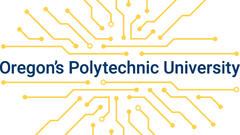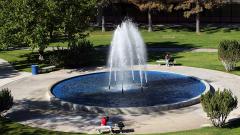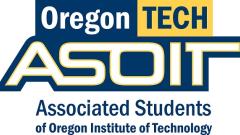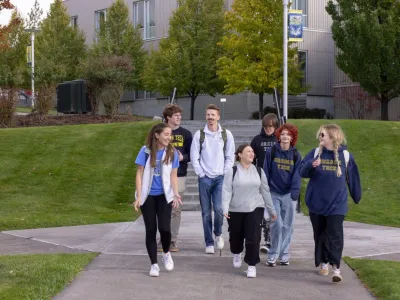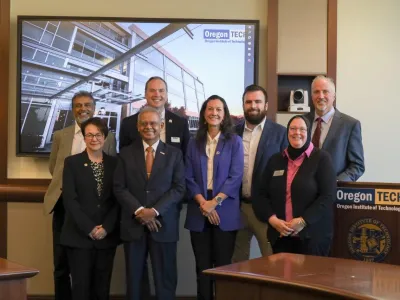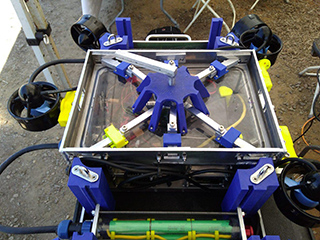
pool in San Diego, California.
OTUS (also a genus of owls and a sibling of Oregon Tech’s owl mascot Hootie) is based on AUVSI (International Association for Unmanned Vehicle Systems). Club members, consisting of mostly senior project students with some juniors and sophomores, studying manufacturing and mechanical engineering technology, computer systems engineering technology and electrical engineering at Oregon Tech.
This is the third year the OTUS team has participated in the competition, and the first award the team has received. The team’s faculty adviser, Dongbin “Don” Lee, Ph.D., an assistant professor of manufacturing and mechanical engineering technology said, “We start from simple ideas before we jump into working on the project, discussing what persistent problems we have and what would be a cool design if we try to fix the problems while enhancing it. Focusing on the goals and benefits, the team came up with brilliant ideas, sketched and drew them into 3D CAD modeling, manufactured and assembled them, facing many challenges to make a real vehicle. However, the students were persistent, finding better solutions from multiple options and continued to do great work.”
The competition requires students to design, fabricate, test and improve on an unmanned, untethered submarine system, and then to pass through given a series of tasks, which mimic ongoing research in autonomous underwater vehicle systems widely performed in the Office of Naval Research, Boeing and Lockheed Martin research. The Robosub competition requires entirely autonomous operation of the sub, meaning that once the sub is deployed from the dock, the submarine is required to recognize the environment and figure out how to navigate the tasks without human input. Although the Oregon Tech team was unable to complete the competition tasks, the team was awarded "Most Innovation in a Vehicle Design" from the Institute of Electrical and Electronics Engineers Oceanic Engineering Society.
Team leader and club president Kai Hattan shared, "I am proud of all of the team members’ hard work and dedication to the success of the team. It is exciting to have the opportunity to work on such a challenging project with so many talented people. We are looking forward to improving and adding to our sub design and competing at the RoboSub competition next year."
The vehicle itself featured many engineered advantages such as lightweight, compact, water-proofed, user-friendly hull and frame design (hatch style) for easy deploy and removal of parts inside hull. Additionally, it had natural water flow cooling systems for heated ESC (electronic speed controller) and batteries, 3D-printed (ABS) brackets mixed with aluminum, easy battery charging, 7-in LCD panel for programming & monitoring, electromagnetic compatibility design for power system, and durable to water pressure just below 100ft. Next year, the team will concentrate on qualifying runs and making better progress in the level of autonomy in the second round.
Software team lead Peter Stine said, "The vision processing system for OTUS has been increasing in scale as easier methods such as the Python language has allowed tools like Tensorflow to be easily integrated with other sensor libraries for Python. This allows us to use one language to unify all types of hardware. Efforts are underway to gain our first junior/senior project members in 2019. OTUS will come back around for best design once again with our new hydraulic arm design and all cylinders firing once we recruit senior/junior project members for the first time."
“We are very proud of our students and the recognition they received in this competition,” said Oregon Tech president, Dr. Nagi Naganathan. “Oregon Tech focuses on nurturing a culture of innovation among our students and our faculty and staff are committed to helping our students build skill sets essential to being innovators in the workforce. Recruiters from top tech companies such as SpaceX and Blue Origin attend these events and I am glad that they got to witness our students' innovative talents.”
Thanks go to the players who participated; Kai Hattan (President & ME lead), Peter Stine (SW lead), Trenton Fender, Brentson Kinoshita, Jay Issara Sucharitakul, Jason Farrell, Greg Spallas. Sponsorship provided from the Resource Budget Committee, Oregon Tech Foundation, Boeing, MathWorks and AUVSI organizers Julianna Smith and Cheri Koch have been crucial components in the success of the team. Additional support was provided by Oregon Tech faculty and staff members Erin Foley, Hallie Neupert, Brian Moravec, Jeff Hayen, David Culler, Todd Breedlove, Steve Addison, Tracy Ricketts, Barbara Metcalf, Barb Meng, Cindy Childers, Leticia Hill, Rachel Winters, Tina and Kirk Bliss, MaryLou Nicholson, Katie Cavendish, Mary Chivers, Sara Moore, Kelly Caleb, Sherry Himelwright, Stuart Sockman, Ashley Van Essen and Valjean Newsome.
To learn more about the competition visit www.auvsifoundation.org/competition/robosub or the OTUS team website at http://auvsioit.wixsite.com/otus, https://twitter.com/OTUS_RoboSub and www.facebook.com/OITRoboSub/.

